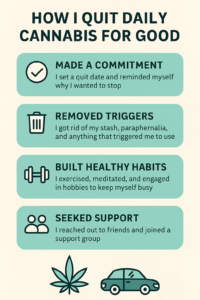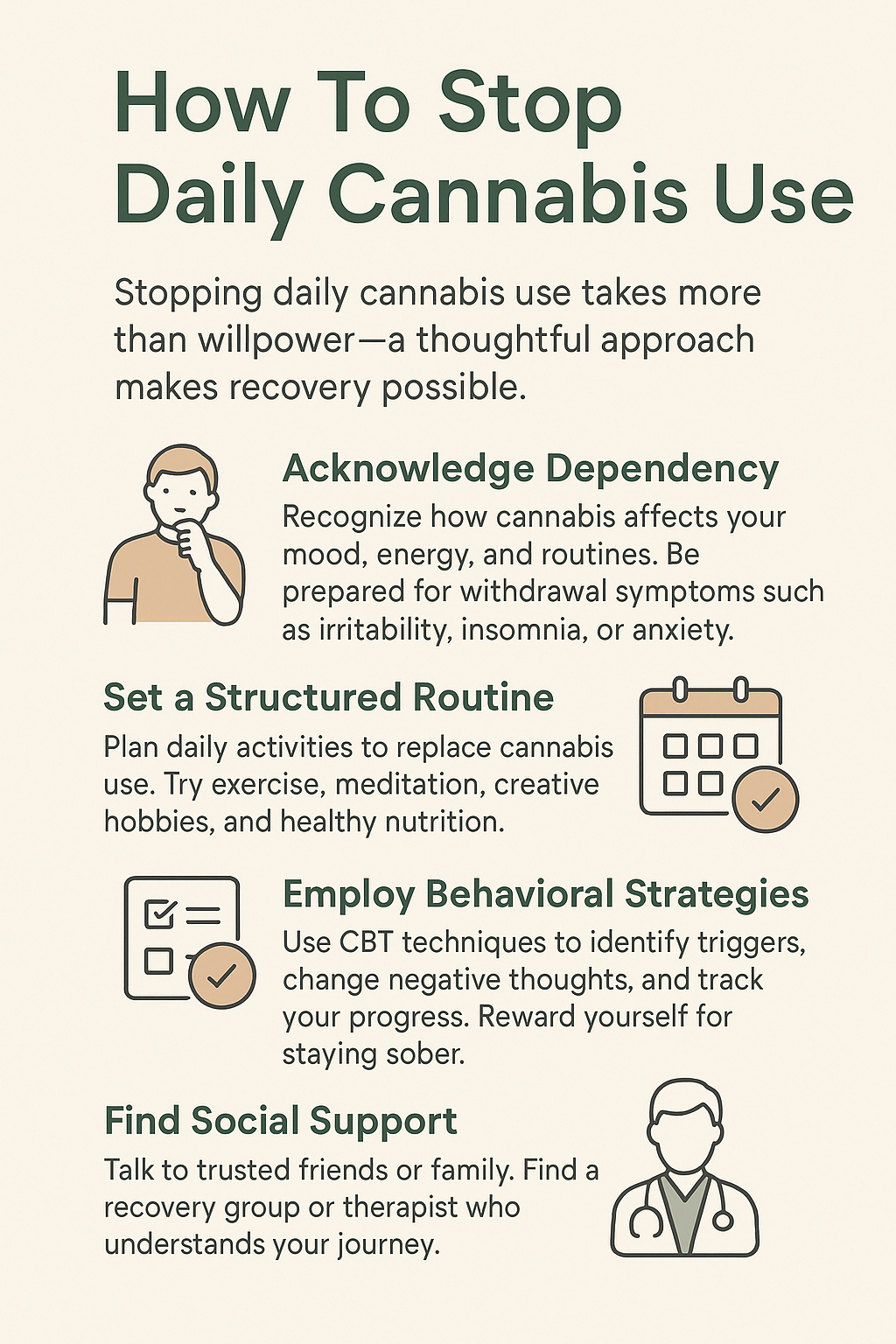
Daily cannabis use can become a habit that impacts your well-being. This guide offers practical steps to help you stop or reduce use with clear, manageable actions.
It might feel as if using cannabis has become second nature – perhaps you find yourself reaching for it at the same time every day or in specific triggering scenarios. The thought of quitting can be overwhelming when you don’t have a structured plan in place. The good news is that making small, consistent changes can help you shift away from this routine and gain control over your habits.
This article explains how to cut down or stop daily cannabis use while still prioritizing overall well-being. It covers evaluating your usage, setting realistic goals, finding healthy alternatives to cope with cravings, and knowing when to seek professional advice. The focus is on gradual change, forming all-in-one habits, and building a support system that genuinely works for you.
Step 1: Recognize and Understand Your Usage Patterns
The first move toward reducing your cannabis use is to identify when and why you use it. Understanding your patterns can help you develop awareness of triggers and situations that contribute to the habit. A clear picture of your routine is a solid foundation for making changes.
Questions to Consider:
- When do I usually use cannabis during the day?
- Which emotions or situations drive me to reach for it?
- What do I gain each time I use it?
- Has cannabis become a regular part of my daily routine?
Reflective Insights:
- Keep a simple journal for a week to monitor your cannabis use.
- Note down the times and surrounding circumstances.
- Pinpoint feelings like boredom, stress, or loneliness that might be acting as triggers.
By mapping out your use, you understand when and where changes could be most effective. This self-awareness is crucial for making lasting adjustments.
Step 2: Set Clear and Realistic Goals
Being clear about what you wish to achieve simplifies planning the necessary steps to cut back or stop altogether. Extremely ambitious targets can easily lead to disappointment, so start with small, manageable milestones.
Guidelines for Goal Setting:
- Decide whether a gradual reduction or quitting cold turkey is better for you.
- Set measurable targets, like reducing the number of daily or weekly uses.
- Outline a timeline for reaching these targets.
Example Goals:
- Cut down to one use per day over the next two weeks.
- Dedicate one full day each week as a cannabis-free day, then increase these days steadily.
- Create specific time windows—like work hours or family meals—during which you avoid cannabis altogether.
With clear, realistic goals, you’ll have a roadmap to stay focused. As you progress, adjust your objectives to keep them both challenging and achievable.
Step 3: Develop a Replacement or New Routine
Replacing an old habit with a more positive routine is a proven strategy for change. When you feel the pull toward cannabis, having a healthier alternative at the ready can be an intense way to counteract the old pattern.
Healthy Alternatives to Consider:
- Spend a few minutes doing light exercise or stretching at times when you’d typically use cannabis.
- Try a short meditation or some deep-breathing exercises.
- Engage in calming hobbies such as reading, drawing, or playing a musical instrument.
- Rearrange your living space to encourage relaxation and focus.
Tips for a Successful Replacement Routine:
- Plan a new activity for moments when you usually reach for cannabis.
- Try different alternatives until you find one that sticks.
- Keep your chosen activity close at hand so you don’t have to scramble for something else to do.
By slowly switching your focus away from cannabis and toward more fulfilling activities, you can gradually form a healthier daily routine.
Step 4: Identify and Avoid Triggers
Triggers often spark cravings. These might include particular times of day, places, or social situations. By identifying these triggers, you can be better prepared to manage or sidestep them.
Common Triggers to Watch For:
- High-pressure or stressful scenarios.
- Moments of boredom or having nothing else to do.
- Social settings where cannabis use is everyday.
- Regular cues include always using after dinner or when unwinding in front of the TV.
Strategies for Managing Triggers:
- Change your surroundings if they consistently remind you of cannabis use.
- Plan engaging activities during peak craving times to keep your mind occupied.
- Practice stress-relief techniques before you find yourself in a triggering situation.
Being proactive about your triggers is a key step toward reducing your overall reliance on cannabis. Over time, working to modify or avoid these cues can naturally lessen the strength of your cravings.
Step 5: Seek Support and Professional Guidance
Support from others can offer perspective, accountability, and much-needed encouragement when change feels challenging. Whether you discuss your journey with trusted friends or consult professionals, sharing it can make a significant difference.
Support Options to Explore:
- Speak with a trusted friend or family member who understands your goals.
- Look into local or online support groups where reducing or stopping cannabis use is a shared focus.
- If needed, consider professional counseling or therapy, especially if your cannabis use is linked to deeper emotional issues.
Why Professional Help Can Be Very Important:
- They can offer strategies for managing cravings and withdrawal symptoms.
- Professionals provide personalized advice, drawing on years of training and real-life experience.
- A structured plan with measurable milestones can be a game plan for lasting change.
Remember, seeking help is a sign of strength. Sharing your difficulties lightens your mental burden and may reveal new ways to tackle everyday challenges.
Step 6: Engage in Healthy Alternatives and Activities
Building a lifestyle that naturally pushes out old habits is another effective strategy against daily cannabis use. Replace the time you previously spent using cannabis with enriching activities that boost your energy and improve your mood.
Ideas for Staying Actively Engaged:
- Try a new hobby, such as cooking, gardening, or creative writing.
- Spend time outdoors; nature’s calming effects can help you manage stress.
- Stay active with regular exercise, whether it’s a short walk or a more vigorous workout.
- Join a community class or learn a new skill that makes you feel challenged and productive.
Replacing your regular cannabis routine with energizing activities often means your cravings naturally take a back seat as you find joy in other areas of life.
Step 7: Stay Consistent and Track Your Progress
Changing habits is rarely a straight path. Tracking your progress and adjusting your approach as needed is essential. Every small success counts and can build momentum over time.
Ways to Keep on Track:
- Maintain a daily or weekly journal to record both improvements and challenges.
- Celebrate the days when you successfully replace cannabis with a healthier alternative.
- Be patient with yourself—new routines take time to establish.
- If setbacks occur, take a moment to review what triggered them and adjust accordingly.
Tools for Accountability:
- Create a simple checklist to mark your cannabis-free days.
- Use a habit tracker or calendar to visualize your progress over time.
- Talk through your journey with someone supportive and positive.
Staying consistent and monitoring your progress can make a real difference. Every step you take, no matter how small, moves you closer to a sustainable change.
Common Questions and Troubleshooting
What if I experience intense cravings?
It’s normal to face powerful cravings as your body and mind adjust to new routines. When intense urges arise, try distracting yourself with an enjoyable activity. Breathing exercises, a short walk, or simply waiting a few minutes can often ease the craving.
How can I handle stress without turning to cannabis?
- Experiment with mindfulness techniques, such as meditation or journaling your thoughts.
- Dive into hobbies or activities that provide a mental break from stress.
- Check in with a friend or counselor who can offer a listening ear and support during tough times.
What should I do if I have a setback?
Setbacks are common. Instead of getting discouraged, reflect on what led to the lapse and consider making small changes for the next time. A setback doesn’t cancel out all your progress—it simply allows you to adjust your plan.
Wrapping Up and Next Steps
Reducing or stopping daily cannabis use is a personal adventure that calls for honest self-reflection, precise planning, and the courage to try new approaches. Every individual’s experience is unique, so finding what resonates with you is essential. Small gains build over time, leading to more control and overall well-being.
A Simple Action Plan:
- Track your cannabis use for several days to spot patterns and triggers.
- Decide on achievable goals for reducing your usage.
- Choose one or two healthy activities to replace the old habit.
- Identify your most common triggers and plan specific ways to avoid or manage them.
- Reach out for support—whether it’s a friend, a support group, or a professional counselor.
Finding the right mix of strategies is crucial for lasting change. The process may include ups and downs, but every improvement is a win. What strategy do you feel ready to try tomorrow? Taking that first step might set off the next stage in reclaiming control over your habits and boosting your well-being.
Video: How I Quit Daily Cannabis For Good

